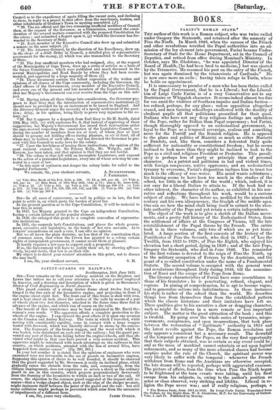SAFETY-GUARDS ON RAILWAYS.
Southampton, 24th June 1851. Sm—Your remarks on the recent railway accident on the Brighton and Lewes line induce me to call your attention to a railway guard employed in America, and a drawing and description of which is given in Stevenson's Sketch of Civil Engineering in North America. This guard consists of a strong timber frame about twelve feet long, hinged to the fore axle of the locomotive engine, and projecting in front of the engine about eight feet. The front end of this frame is shod with iron, and is kept about an inch above the surface of the rails by means of a pair of wheels about two feet diameter, attached to the frame some three feet in advance of the engine, and which run of course on the rails. The benefit of this contrivance may be best explained in Mr. David Ste- venson's own words. " The apparatus affords a complete protection to the wheels of the engine. I experienced the good effects of it upon one occasion on the Camden and Amboy Railway. The train in which I travelled, while moving with considerable rapidity, came in contact with a large waggon loaded with firewood, which was literally shivered to atoms by the concus- sion. The fragments of the broken waggon, and the wood with which it was loaded, were distributed on each side of the railway ; but the guard pre- vented any part of them from falling before the engine-wheels, and thus ob- viated what might in that case have proved a very serious accident. This apparatus might be introduced with much advantage on the railways in this country, on which accidents, attended with the loss of several lives, have happened from similar causes." (Pp. 260, 261.) In your last number it is stated that the opinions of engineers who were examined were not favourable to the use of guards on locomotive engines. Supposing this opinion of theirs to be well founded, it should be observed that the guard suggested by Mr. Stevenson is really an inclined plane, which gradually raises the obstacle from the rails, and consequently, from the oblique impingement, does not experience so severe a shock as the ordinary in use in this country, which projects perpendicularly downwards om the framing of the locomotive to within an inch or two of the rail. Of course, the objection to the common guard suggested at the inquest still re- mains—that a wedge-shaped object, such as the edge of the sleeper presents, might insinuate itself between the point of the guard and the rail : but still many collisions might perhaps be prevented which arise from the encounter of impediments of a different form. I am, Sir, yours very obediently, JAMES Comm.


























 Previous page
Previous page